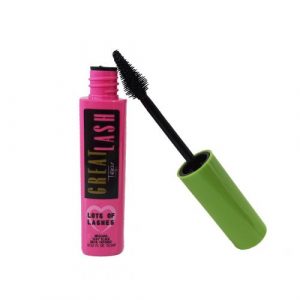Great Lash Tejar Mascara para ojos
8.4

Ingredientes
Water
Ingrediente generalmente considerado seguro para su uso en productos de Belleza y Cuidado Personal.
Beeswax
Ingrediente generalmente considerado seguro para su uso en productos de Belleza y Cuidado Personal, en las condiciones actuales de concentración y prácticas de uso.
Ozokerite
-
Shellac
-
Glyceryl Stearate
Ingrediente clasificado como seguro para su uso como ingrediente cosmético.
Triethanolamine
Existen restricciones en cuanto a la concentración máxima permitida y el tipo de formulaciones en los que puede utilizarse este ingrediente. Potencialmente irritante y sensibilizador de la piel y del sistema respiratorio.
Propylene Glycol
Existen restricciones en cuanto a la concentración máxima permitida y el tipo de formulaciones en los que puede utilizarse este ingrediente. Potencialmente irritante y sensibilizador de pieles sensibles.
Stearic Acid
Ingrediente generalmente considerado seguro para su uso en productos de Belleza y Cuidado Personal, en las condiciones actuales de concentración y prácticas de uso.
Sorbitan Sesquioleate
-
Methylparaben
Ingrediente (parabeno) potencialmente estrogénico (en proceso de evaluación).
Quaternium-15
-
Quaternium-22
-
Simethicone
-
Butylparaben
Ingrediente (parabeno) potencialmente tóxico a nivel reproductivo, perturbador endocrino, con capacidad de alterar la información genética de un organismo biológico y peligroso para la vida acuática.
CI 77491
Ingrediente (Ferric oxide) potencialmente bioacumulable.
CI 77492
Ingrediente potencialmente bioacumulable y con impacto negativo en la vida acuática.
CI 77499
Ingrediente (tri-iron tetraoxide) generalmente considerado seguro para su uso en productos de Belleza y Cuidado Personal, en las condiciones actuales de concentración y prácticas de uso.
Titanium Dioxide
Existen restricciones en cuanto a la concentración máxima permitida y el tipo de formulaciones en los que puede utilizarse este ingrediente. Potencialmente irritante y sensibilizador de la piel.
CI 77007
-
Mica
Ingrediente generalmente considerado seguro para su uso en productos de Belleza y Cuidado Personal. Sin embargo, la exposición prolongada a este ingrediente puede resultar perjudicial para las vías respiratorias.
Más información
El análisis de ingredientes ha sido elaborado por investigadores del CONICET (*) en base a las siguientes referencias bibliográficas:
- CIR (Cosmetic Ingredient Review). Annual Review of Cosmetic Ingredient Safety Assessments—2002/2003. Washington DC.
- K. Aschenbeck, E. Warshaw. Allergenic Ingredients in Facial Wet Wipes. Dermatitis (2017) 28(6):353–359
- A. C. de Groot, H. L. M. van der Meeren, J. Willem Weyland. Contact Dermatitis (1988) 19: 77-78
- Cosmetic Ingredient Review (CIR)
- Final Report of the Amended Safety Assessment (2004). International Journal of Toxicology, 23 (2), 55–94.
- Material Safety Data Sheet MSDS# 23930
- https://www.cosmeticsinfo.org/ingredient/triethanolamine.
- Stout, M. D., Kissling, G. E., Suárez, F. A., Malarkey, D. E., Herbert, R. A., & Bucher, J. R. (2008). Toxicologic pathology, 36(6), 783-794.
- ACGIH, IARC, NTP, or CA Prop 65.
- Final Report on the Safety Assessment of Propylene Glycol and Polypropylene Glycols. (1994). Journal of the American College of Toxicology, 13(6), 437–491.
- US - FOOD & DRUG Administration (FDA). Generally Recognized as Safe (GRAS) Substances (SCOGS) Database (SCOGS Number 27,1973. Conclusion 1)
- CIR (Cosmetic Ingredient Review). 2006. CIR Compendium, containing abstracts, discussions, and conclusions of CIR cosmetic ingredient safety assessments. Washington DC.
- European Commission Legislation (Regulation (EC) N° 1223/2009 y 2019/831, Annexes I to VI and all the amendments to the cosmetics regulation).
- EC (Environment Canada). 2008. Domestic Substances List Categorization. Canadian Environmental Protection Act (CEPA) Environmental Registry.
- American Society of Health-System Pharmacists 2013
- Drug Information 2013. Bethesda, MD. 2013
- SCCNFP/0005/98 (Scientific Committee on Cosmetic Products and Non-Food Products) Titanium Dioxide, adopted by the SCCNFP (2000). More information available online: http://ec.europa.eu/health/scientific_committees/consumer_safety/docs/sccs_o_136.pdf
- International Standards Organization (1995). Air Quality Particle Size Fraction Definitions for Health-related Sampling. (ISO Standard 7708), Geneva.
- Health and Safety Executive (2000). General Methods for Sampling and Gravimetric Analysis of Respirable and Inhalable Dust: Methods for the Determination of Hazardous Substances: MDHS 14/3. London.
- IARC: International Agency for Research on Cancer. IARC Monographs Volume 93. Titanium Dioxide. Pg. 199. Available online: https://monographs.iarc.fr/ENG/Monographs/vol93/mono93-7.pdf
- Moran CA et al. Hum Pathol 22 (5): 450-4 (1991)
- Pimentel JC. Acta Med Port 5 (6): 307-13 (1992)
- Rode LE et al. Acta Pathol Microbiol Scand A 89 (6): 455-61 (1981)
- Yamadori I et al. Acta Pathol Jpn 36 (5): 783-90 (1986)
- Fryzek JP et al. J Occup Environ Med 45 (4): 400-9 (2003)
- Churg A et al. Am J Physiol 277 (5 Pt 1): L975-82 (1999)
- Donaldson K et al. Inst Occupat Med Edinburgh Report No TM/88/01 (1988)
- https://www.cdhfinechemical.com/images/product/msds/110_1478813374_TitaniumDioxide-CASNO-13463-67-7-MSDS.pdf
- Aruoja V et al. Sci Total Environ 407 (4): 1461-1468 (2009)
- Heinlaan M et al. Chemosphere 71 (7): 1308-1316 (2008)
- Wiench K et al. Chemosphere 76 (10): 1356-65 (2009)
- Griffitt RJ et al. Environ Toxicol Chem 27 (9): 1972-78 (2008)
- Hulo S, Cherot-kornobis N, Edme JL, de Broucker V, Falgayrac G, Penel G, Legrand-Cattan K, Remy J, and Sobaszek A. “Mica dust and pneumoconiosis: example of a pure occupational exposure in a muscovite milling unit.” J Occup Environ Med. 2013 Dec
- 55(12):1469-74. Print.
(*) Según el ranking SCImago 2020, el CONICET alcanza la segunda posición entre las instituciones académicas y de investigación más prestigiosas de América Latina. A nivel mundial, ocupa la posición 230 entre 7000 instituciones privadas y gubernamentales.

